SR Max is a slip resistant shoe provider. They work with businesses of all sizes to improve employee safety through customized slip resistant shoe programs to meet your specific needs. They have compiled some interesting statistics about workers compensation slip-and-fall injuries.
Note from R. Shafer: On most of the loss runs I have examined, Slip/Trip/Fall is VERY common regardless of the industry so a shoe program might be worth considering. We don't endorse any particular product, but Sr. Max was willing to write an article for us about this topic, so the links are to their website. Hopefully the article will be educational on risk techniques you will find useful.
Did You Know?
Slip, trip and fall injuries make up 15 percent of all worker’s compensation claims.
The average slip and fall worker’s compensation claim is nearly $22,000.
Sixty-five percent of lost work days are due to slip and fall accidents.
Twenty-two percent of slip and fall incidents resulted in more than 31 days away from work.
Twenty-four percent of workplace slip and falls can be directly attributed to footwear.
How can I protect my employees from slip and falls?
A great way for an employer to reduce slip and fall accidents is with a company-wide slip resistant shoe program. This program should be a part of an overall safety plan and can be handled by the safety director or loss prevention specialist in the organization. A good slip resistant shoe program can reduce slip and falls by 50 percent or more with little or no cost to the employer.
By mandating employees wear appropriate footwear for their working environment and providing guidance about where and how to purchase slip resistant shoes, businesses can proactively reduce their accident rates and better protect their employees.
How do slip resistant shoes prevent slip and falls?
Slip resistant shoes have a specially made sole that offers increased resistance to sliding or skidding in wet or greasy surface conditions. This sole is made from a softer rubber compound that is designed to provide more traction by gripping the microscopic roughness of the walking surface. Additionally, slip-resistant shoe soles typically feature a grid-like tread pattern that funnels liquid out from under the shoe, preventing hydroplaning on water or grease.
How do I know my employees are wearing the right shoes?
Not all slip resistant shoes perform equally. Make sure that employees are only wearing shoes that have been tested and have a slip resistance rating. Many of the shoes from retail shoe stores claim to be slip resistant, but don’t offer any significant increase in protection for your employees. A quality slip resistant shoe vendor should be able to produce test results to verify the slip resistance of their shoes.
What styles of slip resistant shoes are there?
Nearly any type of work shoe can be made with a slip resistant sole. Depending on your workplace, the shoe styles your employees wear will vary:
1. If you run a restaurant, your kitchen workers might be wearing waterproof clogs, while your servers could be wearing oxfords.
2. A hospital or long-term care facility will be a great setting for comfortable, supportive sneakers.
3. An industrial or manufacturing setting needs something tougher, such a steel toe or comp toe work boot.
4. Consider keeping a stock of various sized overshoes on hand for new hires to wear until they get proper footwear, or for visiting supervisors.
For more information, visit www.srmax.com or call 877.776.2933.
MODIFIED DUTY CALCULATOR: www.LowerWC.com/transitional-duty-cost-calculator.php
SUBSCRIBE: Workers Comp Resource Center Newsletter
Do not use this information without independent verification. All state laws vary. You should consult with your insurance broker or agent about workers comp issues.
©2011 Amaxx Risk Solutions, Inc. All rights reserved under International Copyright Law. If you would like permission to reprint this material, contact
















